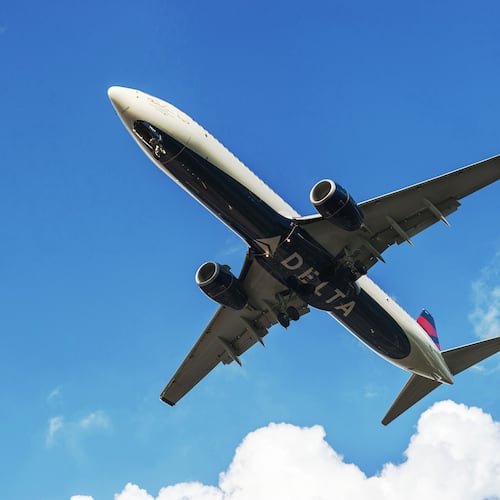The small crew operating a Norfolk Southern train in eastern Ohio earlier this month received a warning about an overheated axle only moments before the freight train derailed, according to a preliminary report issued Thursday from the National Transportation Safety Board.
While final conclusions and recommendations could take more than a year, investigators have been focused on that axle as the cause of the Feb. 3 accident that sent 38 cars off the rails, including 11 carrying hazardous materials, sparking a fire and leading to the area’s temporary evacuation.
“We know what derailed this train, but we have a lot of questions,” NTSB Chairwoman Jennifer Homendy said during a press conference.
The 149-car train, operated by Atlanta-based Norfolk Southern, had been traveling at just under the 50 mile-per-hour speed limit, according to the NTSB. As the axle’s bearing heated, reaching 253 degrees above the air temperature, the engineer heard a “critical audible alarm message,” saw fire and smoke, halted the train and reported the derailment.
The threshold that triggers the alarm is set by the railroad, and whether that should change is not yet certain, Homendy said.
“We want to see what caused the bearing to fail,” she said. “We have never seen an accident that wasn’t preventable.”
NTSB has no enforcement power and officials are often frustrated that its findings and recommendations are ignored. But Homendy said the agency is persistent.
“Our whole goal is to improve safety,” she said. “We don’t give up and we won’t give up on this one.”
The railroad places wayside hot-box detectors that can detect heat from a bearing before it fails from overheating. Norfolk Southern CEO Alan Shaw said during a CNN Town Hall Wednesday that the company is testing and calibrating those detectors.
In a statement late Thursday, the company said it supports the NTSB investigation, citing the preliminary report that showed its crew had been operating below the speed limit.
The wayside detectors on the Norfolk Southern network were set to trigger an alarm “at a temperature threshold that is among the lowest in the rail industry,” the statement said.
However, “(o)ut of an abundance of caution, Norfolk Southern is now inspecting all of the nearly 1,000 wayside heat detectors on its system.”
Those devices are crucial to avoiding problems, said Allan Zarembski, director of the Railroad Engineering and Safety Program at the University of Delaware.
“This is a pretty well-documented and recognized category of failure that doesn’t happen very often,” he said. “There’s a lot of technology deployed by the railroads to try to prevent these derailments and generally they’re very successful.”
But even when detectors are placed about 25 miles apart along the railroad tracks, “it’s still possible for a bearing to pass through a certain detector, get a clean reading and then burn up,” he said.
A few days after the crash, officials conducted a controlled burn to destroy some of the remaining materials, hoping to limit both the risk of explosion and the extent of toxins getting into the local environment. The fire sent smoke and pollutants soaring into the sky.
The incident reignited arguments about safety, efficiency and profit-seeking, as well as who should pay for the clean-up, while federal and local officials struggled to ensure the area’s water and air were safe. Air samples and tests of municipal water were shown to be safe, said officials, but concerns remain about private well water.
Earlier this week, the U.S. Environmental Protection Agency said that Norfolk Southern is financially responsible for clean-up at the accident site.
The government response also has become a political issue.
Some critics alleged U.S. Transportation Secretary Pete Buttigieg initially did too little to hold Norfolk Southern accountable. He’s since visited the area and called for tougher safety standards and urged Congress to raise the cap on fines against railroads for safety violations.
Former President Donald Trump also visited East Palestine, which had voted overwhelmingly for his failed re-election bid in 2020. Trump criticized the federal response, although during his term, the Federal Railroad Administration loosened some safety regulations pursued under President Barack Obama.
Among the changes was the cancellation of a 2015 rule that required trains carrying large volumes of flammable liquids to have advanced brakes.
Critics say the push for greater efficiency has meant greater risk to communities. Labor groups have said the company’s staffing cuts in recent years have also made the trains less safe, while environmental groups say the industry’s emphasis on efficiency is misguided.
“This is an argument that, if carried to its logical extent, would mean that we wouldn’t regulate anything,” said Kristen Boyles, staff attorney for EarthJustice, which litigates environmental issues.
Norfolk Southern maintains that it is doing everything possible to mitigate the disaster.
The company set up an assistance center to aid families and businesses and says it has distributed more than $7 million to cover costs. Norfolk Southern also said it has donated $220,000 to the East Palestine Fire Department, provided air purifiers for some residents, funded air monitoring at local schools, and has contributed $25,000 to the Ohio Red Cross.
The Latest
Featured



